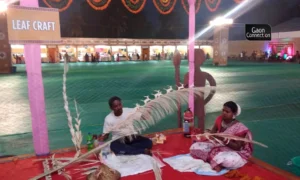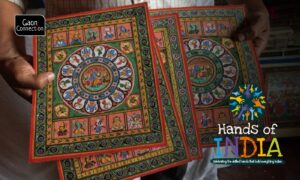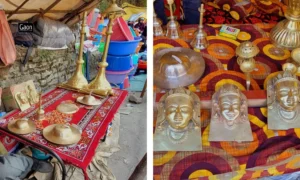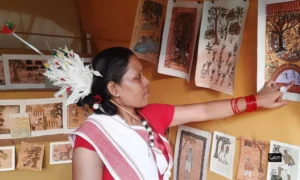Jardhova (Panna), Madhya Pradesh
Pointing towards the cluster of rocks situated in the middle of a grassy forest, 65-year-old Prembai Gond told Gaon Connection that the red markings on the rocks are witches’ creations and are extremely ominous.
“These drawings on the rocks are khoon ki putariya (images drawn in blood) and it is advised not to go near them. We believe that witches drew these images by using the blood of infants,” the adivasi woman said.
Whatever the reason behind the tribal tales around the rocks be, these beliefs have so far protected the ancient cave art embedded deep within the forests of Madhya Pradesh’s Panna Tiger Reserve. But increasing encroachment and vandalism of the rocks in recent times have raised concerns about the need to conserve the historical sites.
According to a journal published in January 2019 in ResearchGate, studies on these cave paintings have ‘established the contemporaneity’ of the rock art with the earliest cognitive expressions in prehistoric art around the world.
Also Read: Here’s how four orphaned tiger cubs in Panna have survived against all odds

Despite being recognised for their historical significance 32 years ago, the government hasn’t dedicated a cohesive conservation effort yet for preserving these archaeological sites.
“Paintings found in Belha and adjacent villages in Panna Chhatarpur region in the Vindhyas provide human and animal figures in the Neolithic Chalcolithic style that resembles the art of Gonds and Kondar tribal people in the area,” the research article titled Rock Art in Madhya Pradesh mentioned.
The research estimates that these paintings are almost 11,000 years old.
A peek into the prehistoric world
The cluster of rocks adorned with the intriguing paintings in the Bhimbethka area of the district encapsulates the lives lived by the prehistoric Gonds — the original inhabitants of the central Indian region.
From hunting animals to tribal practices like human head hunting, these red-coloured drawings depict lives of the prehistoric dwellers of the area which is presently situated near the Jordha village which is at a distance of 18 kilometres from the district headquarters.
In 1990, the Bhopal division of the Archaeological Survey of India (ASI) declared these sites to be monuments of national importance.These rocks are found to be within the caves which provide a resting place for the local inhabitants to the present day.
Also Read: The sparkle of Panna’s diamond hides its underbelly of illegal mines and impoverished workers
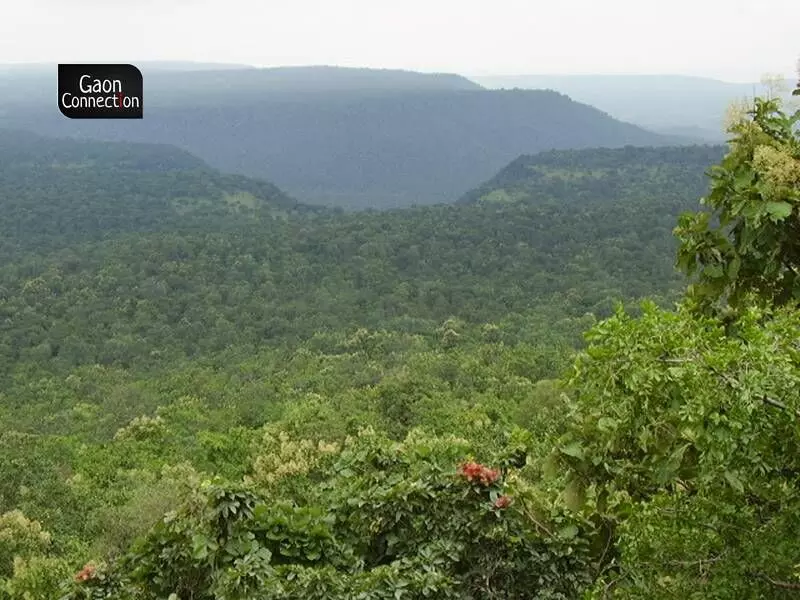
Shyamendra Singh Binni, a former member of the State Wildlife Board told Gaon Connection that it is intriguing that the prehistoric adivasi rested in these caves as they provided a cool shade. “The point that our ancient ancestors leisurely spent their time drawing paintings in these caves is amazing to think of,” Binni told Gaon Connection.
“There are dozens of such sites across the district where such rock paintings are found. Drawings depicting the killing of an animal by a caveman’s arrow are common. Also, scenes of mating are also found,” he added.
Conservation needed
Despite being recognised for their historical significance 32 years ago, the government hasn’t dedicated a cohesive conservation effort yet for preserving these archaeological sites.
Panna-based environmental activist Hanumant Singh told Gaon Connection that these rock paintings are a rich source of heritage for the area and can be used to promote tourism activities in the region.
“Panna’s forests have this beautiful arcade of prehistoric cave art. Along with the environment, it is crucial to conserve these sites as acts of vandalism and deforestation pose a serious risk to the safety of these sites. It can also assist in the area’s development if it is used for tourist activities,” Singh said.
Meanwhile, the research article on the rock paintings mentioned that Madhya Pradesh and its surrounding neighbourhood being largely forested and inhabited by tribal populations, has provided a safe bastion for rock art for a long time.
“However, because of steady destruction of forests in the region, the non homogenous and honey combed structure of softer sandstone has permitted salt efflorescence (deposition on surface) and cryptogrammic (microbial) growth, hastened by [capillary] flow of water through [interstitial] pores,” it stated.
The activist also complained that with people have started vandalising the rocks by writing their names on it.
“People no longer care for the tribal beliefs and often vandalise these drawings by writing their names on them. I hope the conservation effort begins soon,” he said.
Also, Rangaiah Sreenivasa Murthy, a retired field director of the Panna Tiger Reserve expressed his concerns that certain activities and construction projects in the region endanger the rock paintings.
“Construction projects like the Ken Betwa River Linking project have the possibility to disturb the ecosystem of the area which is detrimental to the safety of these historical sites within the forest,” Murthy said.








